Noise Benchmarks
We used an SPL meter with a sensitivity of down to 30 dB in A-weighted mode to measure noise levels. While it may not be the most realistic placement for the meter, measurements were taken at a distance of 12 inches from the rear of the case. This was necessary to get meaningful differences from the systems in idle mode, though we admit it's not entirely accurate - especially with the fans frequently located at the rear of the case. We also measured from the front-right area of the computer at a range of 48 inches, roughly where we would expect most people to sit in relation to their case. A few of the units were quiet enough that the sensitivity of our SPL device came into play at the larger distance, and while none dropped below 30 dB, accuracy becomes suspect the closer we get to 30 dB. Noise tests were also taken with and without an X800Pro installed; integrated graphics were used if available, or a fanless MX440 or 6600 card was used for the other systems.
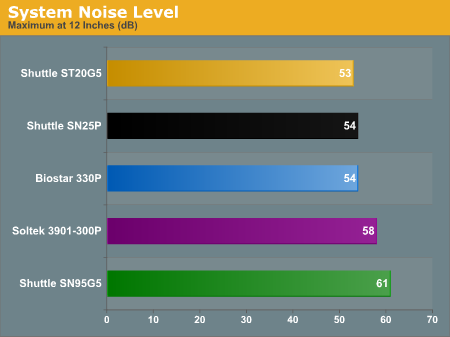
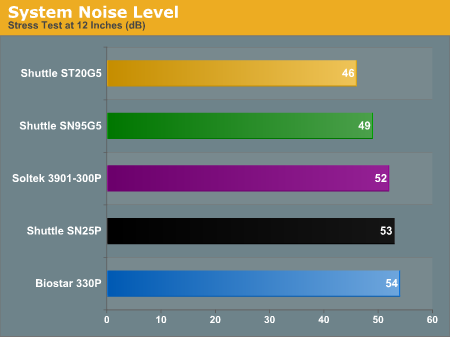
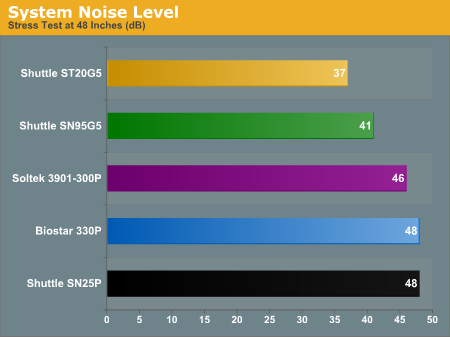
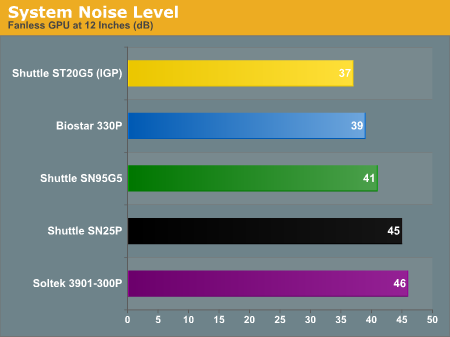
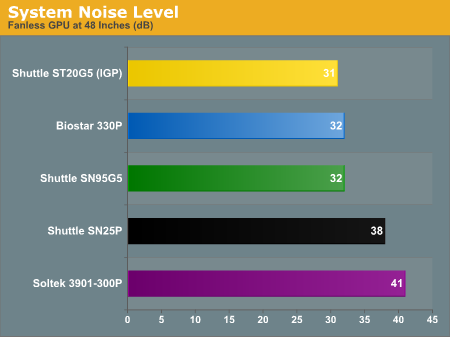
The items to which we'd pay the most attention are the idle (minimum) noise levels and the stress test noise levels. If you plan on using a quiet GPU, look at those results as well. All of these systems are very quiet in typical use - even the Soltek is quieter than most desktop ATX cases that have two or more 80mm fans installed. The stress tests make the 330P and SN25P look worse than what they really are, as the peak noise level that we measured at one specific point in the stress test isn't a continual irritant. Most of the time, they run at around 48 to 50 dB and it would only spike up to 53/54 dB periodically (once every couple of minutes). Overall, the G5 units prove the maturity of the design, as they come out as the quietest systems in the stress test and fanless GPU tests.










29 Comments
View All Comments
JarredWalton - Wednesday, August 10, 2005 - link
So I spoke too soon. After finishing this article, I just happend to come across http://www.newegg.com/Product/Product.asp?Item=N82...">the new Aopen 939 SFF. That actually looks pretty promising, though the IGP isn't going to beat the ST20G5 that I can see (no DVI port). Time to put in a request for that unit....rqle - Wednesday, August 10, 2005 - link
Price of these SFF are getting quite pricey lately. So much to the point when you add the cpu, hard drive, memory, video card, optical drive AND LCD it will comes very close to the price of a good high end laptop on a good day. Dell 17inch 9300 w/6800 on a VERY good sale day comes just over the price of these SFF 'system.' Big fan of these SFF, but prices should be a little bit more reasonable for me to buy again.JarredWalton - Wednesday, August 10, 2005 - link
I agree with you on a lot of that, but a SFF with a 19" (or larger) LCD and a 6800GT/X800XL is pretty much going to stomp all over any similarly priced laptop. There's basically a $150 price premium to get a high-end SFF case, which is going to prevent many from buying. Still, some people buy $200 cases just because they look nice, so it's all a matter of taste.If you need portability, though, there are very few options other than getting a laptop. Personally, laptops and gaming are something I just don't care about. I'd get a cheap laptop for the office work I do and then keep a second system at home for any gaming. Some of course feel otherwise, but laptop keyboards and such just don't do it for me.
R3MF - Wednesday, August 10, 2005 - link
love it.BigT383 - Wednesday, August 10, 2005 - link
I have a first-generation SN95G5. I bought it thinking that since it's socket 939 I'd be able to upgrade to dual-core when it came out.Apparently this isn't the case, but I haven't seen anybody say they've tried it yet- so far there seem to be only rumors.
So I know this is a weird request but what I'd like to see right now is an article testing a CPU like the Athlon X2 4400+ on the three different versions of the SN95G5.
I can understand that X2s need a bios update, but the physical motherboard shouldn't be holding me back, right?
dcuccia - Thursday, August 18, 2005 - link
X2 support for the SN25P w/o USB2 issues is now available through a BIOS upgrade:http://www.shuttle.com/share/fae/hq/download/bios_...">http://www.shuttle.com/share/fae/hq/download/bios_...
JarredWalton - Thursday, August 18, 2005 - link
Thanks, I made a quick comment on the SN25P page to mention this.JarredWalton - Wednesday, August 10, 2005 - link
I'm going to be dropping an X2 3800+ into the SN95G5v2 just to see what happens. I'll try to get some official word from Shuttle on the matter as well. I really have no idea what the SN95G5v1 will support. I think the main change between it and v2 was a switch from an 80mm fan to a 92mm fan.Zirconium - Wednesday, August 10, 2005 - link
I love the roundup articles. I find them to be the most useful because they allow you to hone in on what you are looking for quickly, and then you can go to other sites and check the reviews that are solely for the products you are looking for.That said, one thing I'm interested is the quality of the integrated graphics on these computers. I have an SK41G and I could tell the difference between the quality of the built-in graphics and the AIW Radeon 7500 that is currently in it. When the integrated graphics were hooked up to a TV (I tried two) you could notice bands moving up the TV.